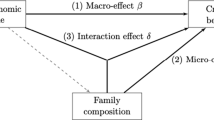Abstract
In this paper, we use an overlapping generations model where individuals are allowed to engage in both legitimate market activities and criminal behavior in order to assess the role of certain factors on the property crime rate. In particular, we investigate if differences in the unemployment rate, fraction of low human capital individuals in an economy, apprehension probability, duration of a jail sentence, and income inequality could be capable of generating large differences in crime rates that are observed across countries. We find that small differences in the apprehension probability and income inequality can generate quantitatively significant differences in the crime rates across similar environments.
Similar content being viewed by others
References
Barclay, G. and C. Tavares. 2003. International Comparisons of Criminal Justice Statistics. Home Office Statistical Bulletin, December.
Becker, G.S. 1968. “Crime and Punishment: An Economic Approach.”Journal of Political Economy 78: 169–217.
Blumstein, A., D. Nagin, and J. Cohen. 1978.Deterrence and Incapacitation: Estimating the Effects of Criminal Sanctions on Crime Rates. Washington: National Academy of Sciences.
Cameron, S. 1998. “The Economics of Crime Deterrence: A Survey of Theory and Evidence.”Kyklos 41: 301–323.
Cooley, T.F. and E.C. Prescott. 1995. “Economic Growth and Business Cycles.” inFrontiers of Business Cycle Research, edited by T.F. Cooley. Princeton: Princeton University Press.
Dahlberg, M. and M. Gustavsson. 2005. “Inequality and Crime: Separating the Effect from Permanent and Transitory Income.” Working Paper Series 2005: 19, IFAU—Institute for Labour Market Policy Evaluation.
DiIulio, J. and A.M. Piehl. 1991. “Does Prison Pay? The Stormy National Debate over the Cost-Effectiveness of Imprisonment.”Brookings Review 9: 28–35.
Ehrlich, I. 1973. “Participation in Illegitimate Activities: A theoretical and Empirical Investigation.”Journal of Political Economy 81: 521–565.
Ehrlich, I. 1981. “On the Usefulness of Controlling Individuals: An Economic Analysis of Rehabilitation, Incapacitation, and Deterrence.”American Economic Review 71: 307–322.
Ehrlich, I. 1996. “Crime, Punishment, and the Market for Offenses.”Journal of Economic Perspectives 10: 43–67.
Fajnzylber, P., D. Lederman, and N. Loayza. 2002. “Inequality and Violent Crime.”Journal of Law and Economics 45: 1–40.
Freeman, R. B. 1996. “Why Do So Many Young American Men Commit Crimes and What Might We Do about It?”Journal of Economic Perspectives 10: 25–42
Grogger, J. 1991. “Certainty vs. Severity of Punishment.”Economic Inquiry 29: 297–309.
Grogger, J. 1998. “Market Wages and Youth Crime.”Journal of Labor Economics 16: 756–791.
Hansen, G. and A. İmrohoroĝlu. 1992. “The Role of Unemployment Insurance in an Economy with Liquidity Constraints and Moral Hazard.”Journal of Political Economy 100: 118–142.
İmrohoroĝlu, A., S. İmrohoroĝlu, and D. Joines. 1999. “Social Security in an Overlapping Generations Economy with Land.”Review of Economic Dynamics 2: 638–665.
İmrohoroĝlu, A., A. Merlo, and P. Rupert. 2004. “What Accounts for the Decline in Crime?”International Economic Review 45: 707–730.
İmrohoroĝlu, A., A. Merlo, and P. Rupert. 2000. “On the Political Economy of Income Redistribution and Crime.”International Economic Review 41: 1–25.
Levitt, S. 1998. “Why Do Increased Arrest Rates Appear to Reduce Crime: Deterrence, Incapacitation, or Measurement Error?”Economic Inquiry 36: 353–372.
Marvell, T.B., and C.E. Moody. 1996. “Specification Problems, Police Levels, and Crime Rates.”Criminology 34: 609–646.
Nilsson, A. 2004. “Income Inequality and Crime: The Case of Sweden.” Working Paper Series, IFAU—Institute for Labour Market Policy Evaluation.
Polinsky, M. and S. Shavell. 1984. “The Optimal Use of Fines and Imprisonment.”Journal of Public Economics 24: 89–99.
Prohaska, C. and W. Taylor. 1973. “Minimizing Losses in a Hostile Environment: The Cost of Defending One's Castle.”The Journal of Risk and Insurance 40: 375–387.
Stigler, G.J. 1970. “The Optimum Enforcement of Laws.”Journal of Political Economy 78: 526–536.
Stokey, N. and Lucas Jr., R.E., with Prescott, E. 1989.Recursive Methods in Economic Dynamics. Cambridge, MA: Harvard University Press.
Witte, A.D. and H. Tauchen. 1994. “Work and Crime: An Exploration Using Panel Data.”Public Finance 49: 155–167.
Author information
Authors and Affiliations
Corresponding author
Rights and permissions
About this article
Cite this article
İmrohoroĝlu, A., Merlo, A. & Rupert, P. Understanding the determinants of crime. J Econ Finan 30, 270–284 (2006). https://doi.org/10.1007/BF02761491
Issue Date:
DOI: https://doi.org/10.1007/BF02761491




